
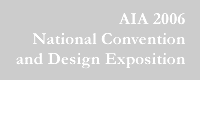
6/2006

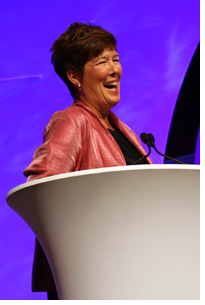 Participants of the AIA Convention Friday general session began practicing its theme of “engagement” from the moment attendees walked in: Seating was arranged alphabetically by schools of architecture so that alumni could sit together and reconnect. AIA President Kate Schwennsen, FAIA, explained, “Since our focus today is engagement, we thought: Why not use this time to become better acquainted? Our national conventions should be a time of sharing not only knowledge, but fellowship.”
Participants of the AIA Convention Friday general session began practicing its theme of “engagement” from the moment attendees walked in: Seating was arranged alphabetically by schools of architecture so that alumni could sit together and reconnect. AIA President Kate Schwennsen, FAIA, explained, “Since our focus today is engagement, we thought: Why not use this time to become better acquainted? Our national conventions should be a time of sharing not only knowledge, but fellowship.”
Schwennsen spoke of four significant trends—globalization, technological revolution, recognition that design matters, and rededication to environmental responsibility—as shaping where the profession is headed. “As the world flattens, we have started to better understand and engage its environmental limits and our impact on its ecology. Surely, the health of the world to come is dependent on our stewardship of this globe,” she noted. “. . . Although all of the world’s inhabitants share responsibility for the future of our planet, the design and construction industry needs to be a leader in navigating us to a better, more sustainable, and equitable world. In the words of St. Luke: ‘For unto whom much is given, much shall be required.’ Indeed, a great deal has been given to us.”
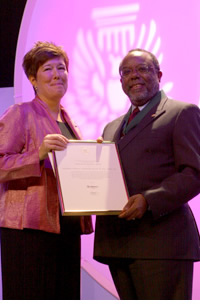 Young Award recipient Landsmark: Engaged with society
Young Award recipient Landsmark: Engaged with society
Schwennsen presented the 2006 Whitney Young Jr. Award to Theodore Landsmark, Assoc. AIA. This eponymous award honors the civil rights leader who at the 1968 AIA national convention challenge AIA members to create a profession that is diverse and inclusive. Landsmark is the AIA Diversity Committee Chair, Boston Architectural Center president since 1997, and 2006 president of the Association of Collegiate Schools of Architecture.
At the lectern, Landsmark first acknowledged his parents, present in the audience. ”They raised me from the housing projects in Harlem to believe in good education, open-mindedness, tolerance, persistence, hard work, and social justice. These are the values that have brought me to this place today.” He also acknowledged many AIA leaders for their support as well as “the women and people of color; and gay, lesbian, and disabled designers; and the ethnically and religiously diverse and divergently thinking professionals who should be with us here today,” he said. “They have struggled to be a part of this profession, and they have too often been overlooked, insulted, and dismissed. They have struggled in isolation and silence to be recognized as your peers. This award is for them, really, and not for me, because it is they whose suffering must be redressed and whose good work must be recognized.”
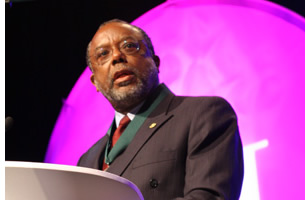 Landsmark said that as a profession, our actions must match our words. Specifically:
Landsmark said that as a profession, our actions must match our words. Specifically:
We must welcome into our firms everyone from multilingual, multicultural communities—the young designers; students; related design professionals; marketing, legal, and business leaders; and, most importantly, the diverse non-architects who support us in the pursuit of a well-designed built environment
We must identify the more diverse role models who can serve as examples of what can be achieved in this profession
We must recruit diversity earlier, not waiting until high school and college to find the young people who will be our colleagues of the future
We all have hiring policies that say we support diversity, but we must change our actual personnel practices so they don’t discriminate against women and caregivers who cannot pursue a career track based on charrettes or only reward those willing to spend time away from their families.
“We are better design professionals and better citizens when we open our minds and hearts to different ways of thinking,” Landsmark concluded. “As I thank you for this recognition today, I also implore each of us to apply ourselves more effectively to ensuring that 30 years from now, we are not still berating ourselves for failing to find effective ways of being a more diverse, inclusive, and welcoming profession that truly reflects the society we serve.”
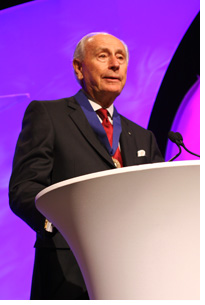 Kemper Award recipient Tittle: Engaged with the profession
Kemper Award recipient Tittle: Engaged with the profession
President Schwennsen then bestowed the Kemper Award upon James D. Tittle, FAIA, of of the Tittle Luther Partnership, Abilene, Tex. Named after the AIA’s first executive director, who served as the Institute’s chief staff officer for 34 years, the Edward C. Kemper Award honors an architect member who has contributed significantly to the profession through service to the Institute. Tittle was singularly honored for his body of design work, as well as serving as chapter president and a member of the board of the Texas Society of Architects, a member of the Institute’s Board of Directors, regional director for the National Council of Architectural Registration Boards, a past member of the Foundation’s Board of Regents, Chancellor of the College of Fellows, and a founding member of the Chancellor’s Cup Golf Tournament.
“I am so glad and proud that I am an architect. I still get goose bumps every time I am introduced as an architect—always have and always will. Ours is such a wonderful profession, and we are so fortunate to be a part of it and especially to have a professional organization such as the AIA that works night and day to take care of us, protect us, and guide us in every facet of our practice,” Tittle told the audience. “Almost 50 years ago Jack Luther and I formed the Tittle Luther Partnership, and, not unlike many of you here, have had a small practice in a small town for all these years—and we have enjoyed it immensely. At that time, we made a conscious decision that to improve our quality of life and make our lives more fulfilling, the practice of architecture should encompass more than the design and production of good architecture, but should include involvement in other areas.
Tittle explained that he and Luther wanted to be an integral part of their community, as well as to be involved in the AIA and the Texas Society of Architects. They wanted to provide a strong commitment to the arts and cultural heritage, and, as they grew older, to be good mentors. “It has worked well for us. The AIA has done a lot more for us than we have for it. It is truly an amazing organization and certainly one that deserves our continued support,” Tittle declared. “The Kemper is hallowed ground and it is a privilege for me to walk in the same footsteps of those whom I admire so much and, believe me, I am treading lightly. It is a high honor and one that I am delighted to receive and humbly accept.”
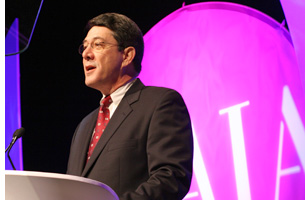 Foundation: Engaged in education and preservation
Foundation: Engaged in education and preservation
American Architectural Foundation President Ron Bogle wrapped up the introduction portion of the Friday general session with a roundup of the AAF’s current programs and initiatives, including:
Administration and co-funding of the Mayors’ Institute on City Design—in partnership the National Endowment for the Arts and the U.S. Conference of Mayors. “Each year, we organize eight or nine institutes and bring together nearly 50 mayors to talk about their urban design issues with leading architects and design experts in a case-study format. Since 1968, more than 625 mayors and some 400 design professionals have participated in the program,” Bogle said.
The Great Schools by Design national initiative addresses the way America’s public schools are planned, designed, and integrated with their communities. Late in 2005, the Foundation convened a national summit on school design in Washington in partnership with the AIA Committee on Architecture for Education. Recommendations from the summit will be released June 12.
Other education initiatives of the AAF include a national K–12 design education program and creation of the Architectural and Design Education Network (ADEN) with the Chicago Architecture Foundation. The inaugural A+DEN Conference is slated for October 27–28 in Chicago. Another program focused on students is AAF’s scholarship for minority and disadvantaged architecture students. “In closing, I would like to provide a brief update on the Octagon,” Bogle said. “In 2005, the AAF received a significant Save America’s Treasures grant to continue the restoration of the Octagon. Ground water problems, decaying exterior wood, a failing roof, and other challenges—all too familiar to those who are engaged in historic preservation—will be addressed with the support of this prestigious matching grant.”
Copyright 2006 The American Institute of Architects.
All rights reserved. Home Page ![]()
![]()
Photos by Aaron Johnson, Innov8iv Design Incorporated.
![]()